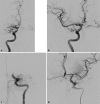Sudden coma from acute bilateral m1 occlusion: successful treatment with mechanical thrombectomy
- PMID: 24926264
- PMCID: PMC4035677
- DOI: 10.1159/000362160
Sudden coma from acute bilateral m1 occlusion: successful treatment with mechanical thrombectomy
Abstract
We report a case with acute small infarct of the left middle cerebral artery in a 72-year-old man with atrial fibrillation documented by MRI and MR angiography. One hour later, he lost consciousness and CT with CT angiography revealed bilateral hyperdense middle cerebral arteries due to occlusion of the M1 segments. Mechanical thrombectomy of the right middle cerebral artery was successfully performed. During that time, thrombosis on the left side had progressed to carotid T occlusion, which was recanalized as well. The patient had a good outcome with slight aphasia and mild paresis of the left hand and could be transferred to rehabilitation 2 weeks later.
Keywords: Bilateral M1 occlusion; Coma; Mechanical thrombectomy; Stroke.
Figures



References
-
- Kwon SU, Lee SH, Kim JS. Sudden coma from acute bilateral internal carotid artery territory infarction. Neurology. 2002;58:1846–1849. - PubMed
-
- Hu WT, Wijdicks EF. Sudden coma due to acute bilateral M1 occlusion. Mayo Clin Proc. 2007;10:1155. - PubMed
-
- Nawashiro H, Wada K, Kita H. Decerebrate posture following bilateral middle cerebral artery occlusion. Intern Med. 2011;50:2063. - PubMed
-
- Sadahiro H, Inamura A, Ishihara H, et al. Fragmental or massive embolization in cardiogenic stroke caused by nonvalvular atrial fibrillation. J Stroke Cerebrovasc Dis. 2014;23:63–68. - PubMed
-
- Gadda D. A case of bilateral dense middle cerebral arteries with CT angiographic confirmation of vascular occlusion. Emerg Radiol. 2003;10:142–143. - PubMed
Publication types
LinkOut - more resources
Full Text Sources
Other Literature Sources

